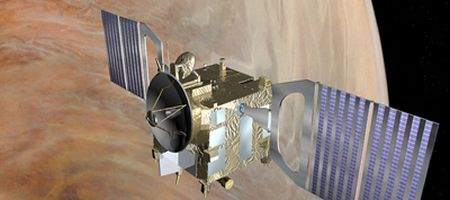ESA scientists reckon they’ve explained a mysterious high-altitude layer of sulphur dioxide discovered by Venus Express – and it provides a stark warning for geoengineers suggesting seeding Earth’s atmosphere with sulphur droplets to combat climate change.

Venus is blanketed in sulphuric acid clouds, formed 50-70 km up when sulphur dioxide from volcanoes combines with water vapour to make sulphuric acid droplets.
Any remaining sulphur dioxide should be destroyed rapidly by the intense solar radiation above 70 km – meaning scientists found it hard to explain the discovery of a sulphur dioxide layer at 90-110 km in 2008.
But new computer simulations lad by Xi Zhang of the California Institute of Technology show that some sulphuric acid droplets may evaporate at high altitude. This frees gaseous sulphuric acid that is then broken apart by sunlight, releasing sulphur dioxide gas.
“We had not expected the high-altitude sulphur layer, but now we can explain our measurements,” says Håkan Svedhem, ESA’s Venus Express project scientist.
But the simulations are bad news for those hoping that injecting artificially large quantities of sulphur dioxide into Earth’s atmosphere at around 20 km could counteract the global warming resulting from increased greenhouse gases.
The idea, advocated by Nobel prize winner Paul Crutzen stems from observations that the release of sulphur dioxide from volcanoes reflects some of the Sun’s rays back into space, cooling the planet.
However, the new work on the evaporation of sulphuric acid on Venus suggests that such attempts would likely fail, as it’s currently impossible to tell how quickly the initially protective haze would be converted back into gaseous – and transparent – sulphuric acid.
“We must study in great detail the potential consequences of such an artificial sulphur layer in the atmosphere of Earth,” says Jean-Loup Bertaux, Université de Versailles-Saint-Quentin, France, principal investigator of the SPICAV sensor on Venus Express.
“Venus has an enormous layer of such droplets, so anything that we learn about those clouds is likely to be relevant to any geo-engineering of our own planet.”






